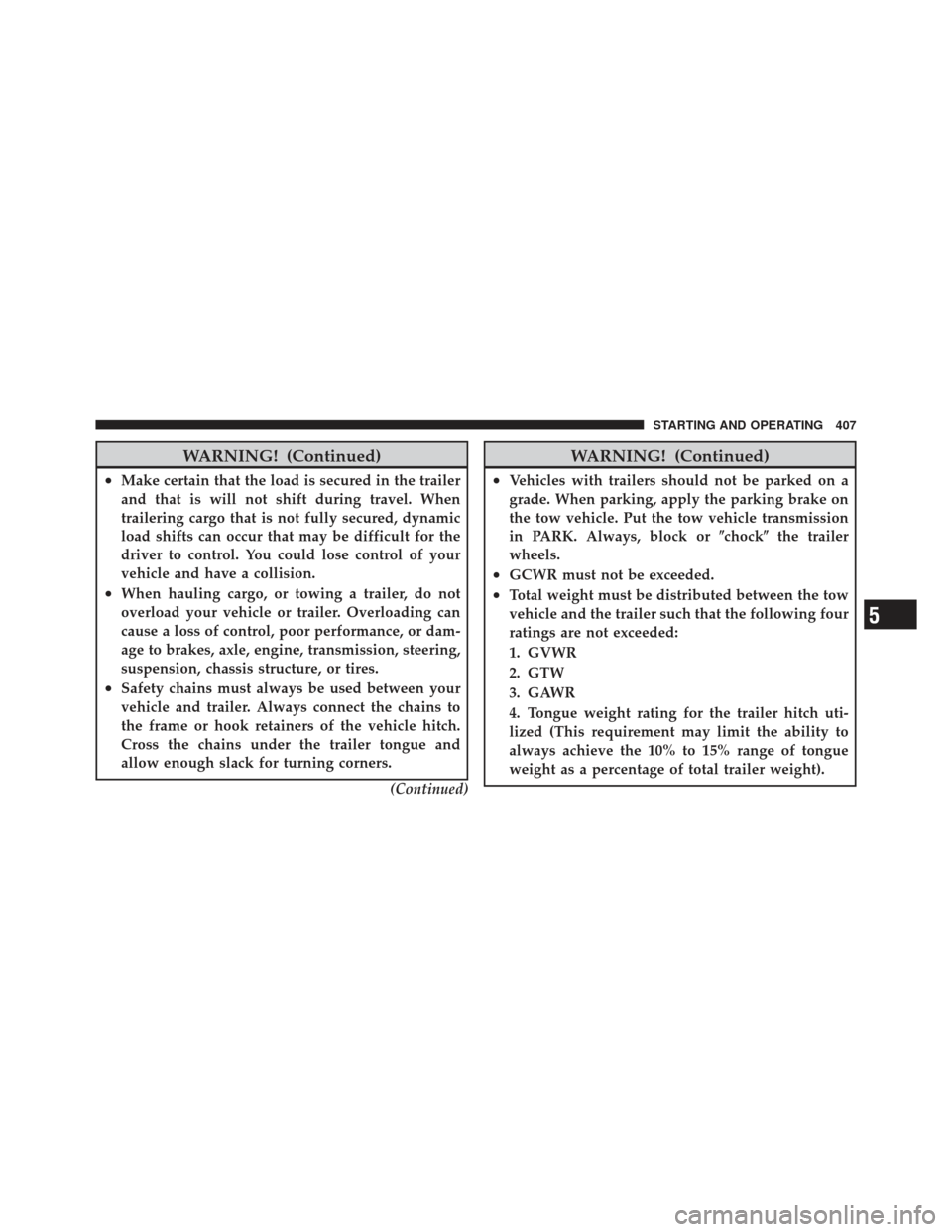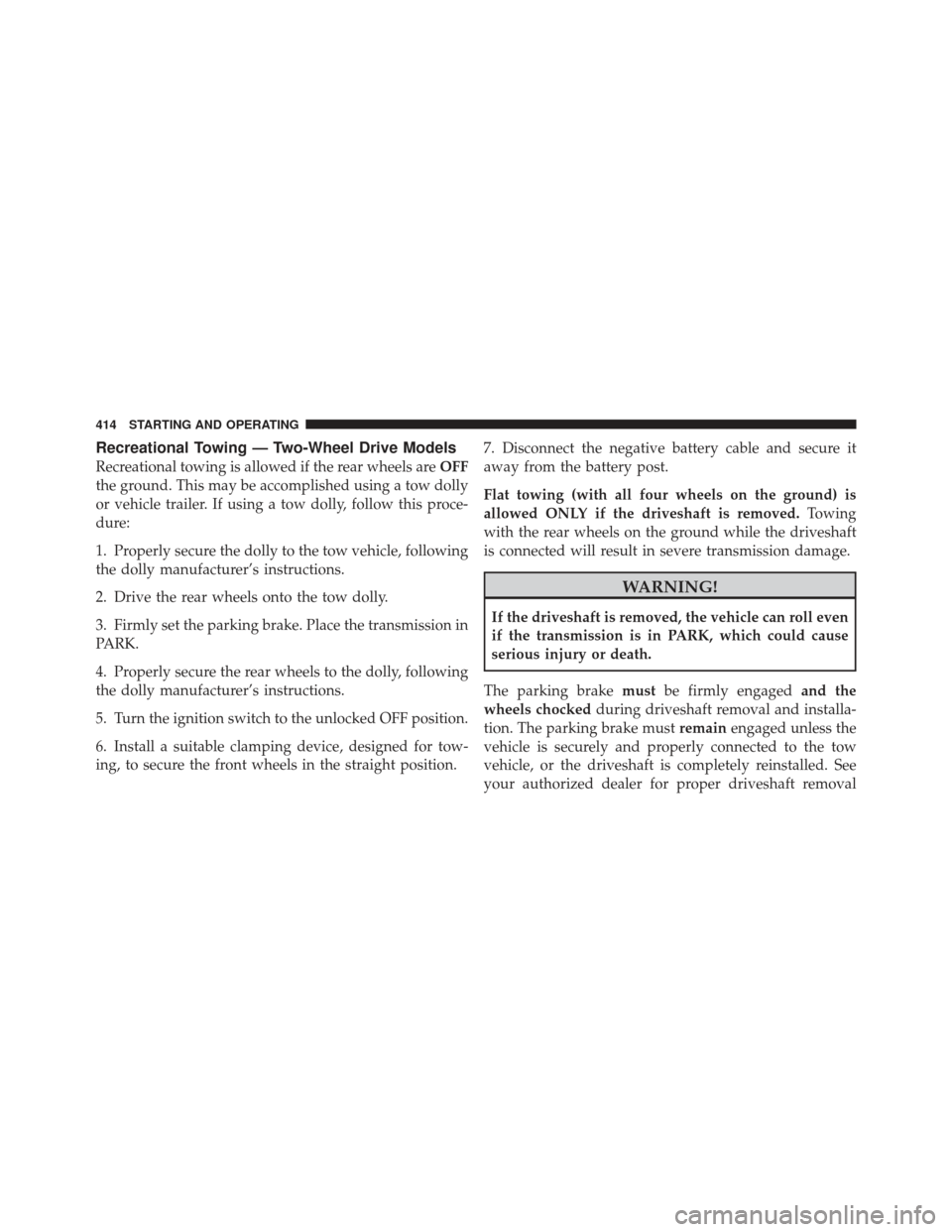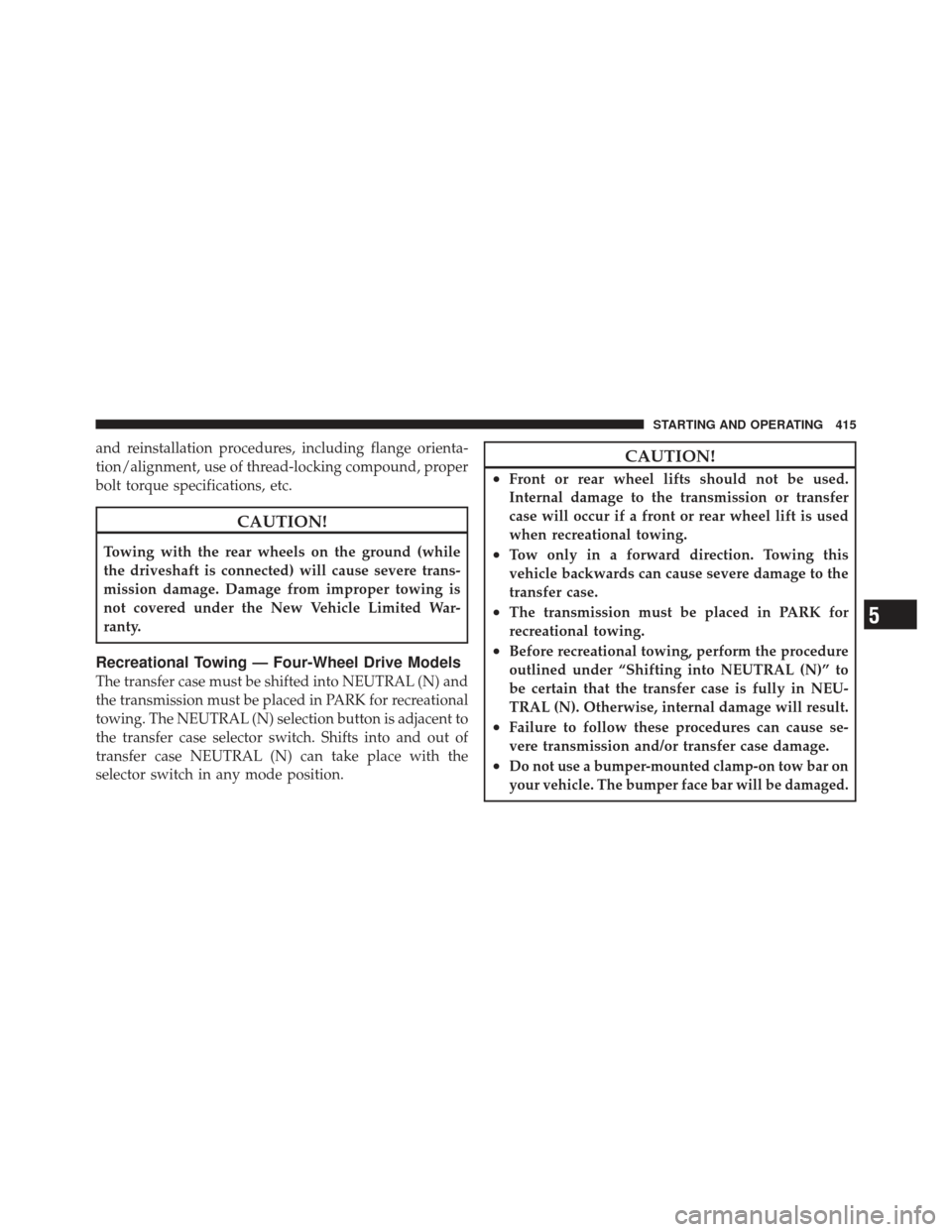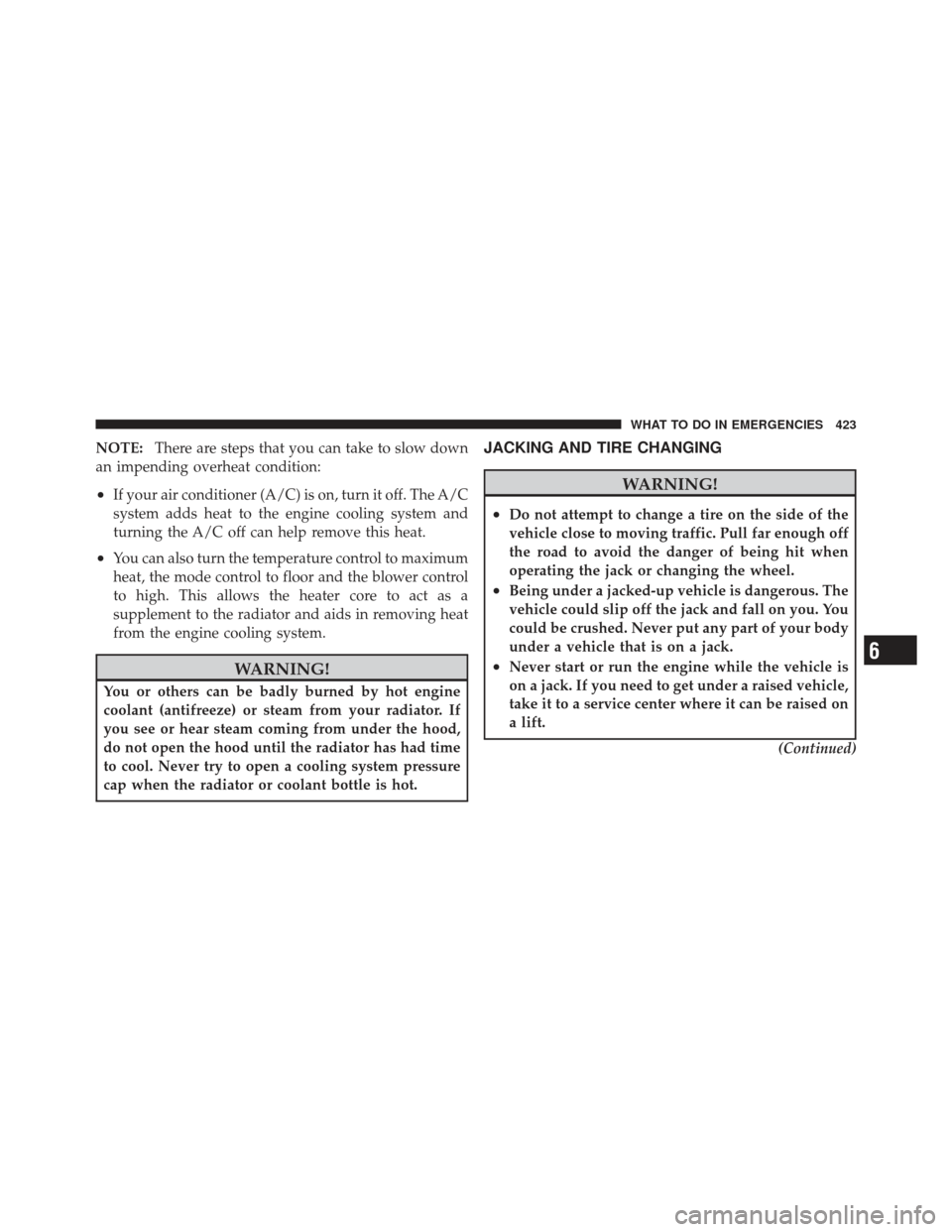Page 407 of 542
Trailer And Tongue Weight
Always load a trailer with 60% to 65% of the weight in
the front of the trailer. This places 10% to 15% of the
Gross Trailer Weight (GTW) on the tow hitch of your
vehicle. Loads balanced over the wheels or heavier in the
rear can cause the trailer to swayseverelyside to side
which will cause loss of control of vehicle and trailer.
Failure to load trailers heavier in front is the cause of
many trailer collisions.
Consider the following items when computing the
weight on the rear axle of the vehicle:
•The tongue weight of the trailer.
•The weight of any other type of cargo or equipment
put in or on your vehicle.
•The weight of the driver and all passengers.
5
STARTING AND OPERATING 405
Page 409 of 542

WARNING! (Continued)
•Make certain that the load is secured in the trailer
and that is will not shift during travel. When
trailering cargo that is not fully secured, dynamic
load shifts can occur that may be difficult for the
driver to control. You could lose control of your
vehicle and have a collision.
•When hauling cargo, or towing a trailer, do not
overload your vehicle or trailer. Overloading can
cause a loss of control, poor performance, or dam-
age to brakes, axle, engine, transmission, steering,
suspension, chassis structure, or tires.
•Safety chains must always be used between your
vehicle and trailer. Always connect the chains to
the frame or hook retainers of the vehicle hitch.
Cross the chains under the trailer tongue and
allow enough slack for turning corners.(Continued)
WARNING! (Continued)
•Vehicles with trailers should not be parked on a
grade. When parking, apply the parking brake on
the tow vehicle. Put the tow vehicle transmission
in PARK. Always, block or�chock�the trailer
wheels.
•GCWR must not be exceeded.
•Total weight must be distributed between the tow
vehicle and the trailer such that the following four
ratings are not exceeded:
1. GVWR
2. GTW
3. GAWR
4. Tongue weight rating for the trailer hitch uti-
lized (This requirement may limit the ability to
always achieve the 10% to 15% range of tongue
weight as a percentage of total trailer weight).
5
STARTING AND OPERATING 407
Page 415 of 542
RECREATIONAL TOWING (BEHIND MOTORHOME, ETC.)
Towing This Vehicle Behind Another Vehicle
Towing Condition Wheel OFF theGroundTwo-Wheel Drive
Models Four-Wheel Drive Models
Flat Tow NONENOT ALLOWED See Instructions
•Transmission in PARK
•Transfer case in NEUTRAL (N)
•Tow in forward direction
Dolly Tow Front
NOT ALLOWED NOT ALLOWED
Rear OK NOT ALLOWED
On Trailer ALLOK OK5
STARTING AND OPERATING 413
Page 416 of 542

Recreational Towing — Two-Wheel Drive Models
Recreational towing is allowed if the rear wheels areOFF
the ground. This may be accomplished using a tow dolly
or vehicle trailer. If using a tow dolly, follow this proce-
dure:
1. Properly secure the dolly to the tow vehicle, following
the dolly manufacturer’s instructions.
2. Drive the rear wheels onto the tow dolly.
3. Firmly set the parking brake. Place the transmission in
PARK.
4. Properly secure the rear wheels to the dolly, following
the dolly manufacturer’s instructions.
5. Turn the ignition switch to the unlocked OFF position.
6. Install a suitable clamping device, designed for tow-
ing, to secure the front wheels in the straight position. 7. Disconnect the negative battery cable and secure it
away from the battery post.
Flat towing (with all four wheels on the ground) is
allowed ONLY if the driveshaft is removed.
Towing
with the rear wheels on the ground while the driveshaft
is connected will result in severe transmission damage.
WARNING!
If the driveshaft is removed, the vehicle can roll even
if the transmission is in PARK, which could cause
serious injury or death.
The parking brake mustbe firmly engaged and the
wheels chocked during driveshaft removal and installa-
tion. The parking brake must remainengaged unless the
vehicle is securely and properly connected to the tow
vehicle, or the driveshaft is completely reinstalled. See
your authorized dealer for proper driveshaft removal
414 STARTING AND OPERATING
Page 417 of 542

and reinstallation procedures, including flange orienta-
tion/alignment, use of thread-locking compound, proper
bolt torque specifications, etc.
CAUTION!
Towing with the rear wheels on the ground (while
the driveshaft is connected) will cause severe trans-
mission damage. Damage from improper towing is
not covered under the New Vehicle Limited War-
ranty.
Recreational Towing — Four-Wheel Drive Models
The transfer case must be shifted into NEUTRAL (N) and
the transmission must be placed in PARK for recreational
towing. The NEUTRAL (N) selection button is adjacent to
the transfer case selector switch. Shifts into and out of
transfer case NEUTRAL (N) can take place with the
selector switch in any mode position.
CAUTION!
•Front or rear wheel lifts should not be used.
Internal damage to the transmission or transfer
case will occur if a front or rear wheel lift is used
when recreational towing.
•Tow only in a forward direction. Towing this
vehicle backwards can cause severe damage to the
transfer case.
•The transmission must be placed in PARK for
recreational towing.
•Before recreational towing, perform the procedure
outlined under “Shifting into NEUTRAL (N)” to
be certain that the transfer case is fully in NEU-
TRAL (N). Otherwise, internal damage will result.
•Failure to follow these procedures can cause se-
vere transmission and/or transfer case damage.
•Do not use a bumper-mounted clamp-on tow bar on
your vehicle. The bumper face bar will be damaged.
5
STARTING AND OPERATING 415
Page 423 of 542
WHAT TO DO IN EMERGENCIES
CONTENTS
�Hazard Warning Flashers ................ 422
� If Your Engine Overheats ................ 422
� Jacking And Tire Changing ............... 423
▫ Jack Location ....................... 424
▫ Spare Tire Stowage ................... 424
▫ Spare Tire Removal ................... 425
▫ Preparations For Jacking ............... 426
▫ Jacking Instructions ................... 426 �
Jump-Starting Procedures ................ 430
▫ Preparations For Jump-Start ............. 430
▫ Jump-Starting Procedure ............... 432
� Freeing A Stuck Vehicle ................. 434
� Shift Lever Override ................... 435
� Towing A Disabled Vehicle ............... 436
▫ Towing Without The Ignition Key FOB ..... 438
▫ Two-Wheel Drive Models .............. 438
▫ Four-Wheel Drive Models .............. 440
6
Page 425 of 542

NOTE:There are steps that you can take to slow down
an impending overheat condition:
•If your air conditioner (A/C) is on, turn it off. The A/C
system adds heat to the engine cooling system and
turning the A/C off can help remove this heat.
•You can also turn the temperature control to maximum
heat, the mode control to floor and the blower control
to high. This allows the heater core to act as a
supplement to the radiator and aids in removing heat
from the engine cooling system.
WARNING!
You or others can be badly burned by hot engine
coolant (antifreeze) or steam from your radiator. If
you see or hear steam coming from under the hood,
do not open the hood until the radiator has had time
to cool. Never try to open a cooling system pressure
cap when the radiator or coolant bottle is hot.
JACKING AND TIRE CHANGING
WARNING!
•Do not attempt to change a tire on the side of the
vehicle close to moving traffic. Pull far enough off
the road to avoid the danger of being hit when
operating the jack or changing the wheel.
•Being under a jacked-up vehicle is dangerous. The
vehicle could slip off the jack and fall on you. You
could be crushed. Never put any part of your body
under a vehicle that is on a jack.
•Never start or run the engine while the vehicle is
on a jack. If you need to get under a raised vehicle,
take it to a service center where it can be raised on
a lift.
(Continued)6
WHAT TO DO IN EMERGENCIES 423
Page 427 of 542
Spare Tire Removal
Fit the jack handle extension over the drive nut located in
the rear cargo area inside the vehicle. Use the lug wrench
to rotate the nut counterclockwise until the spare is on
the ground with enough slack in the cable to allow you to
pull the tire out from under the vehicle.CAUTION!
The winch mechanism is designed for use with the
jack extension tube only. Use of an air wrench or
other power tools is not recommended and they can
damage the winch.
When the spare is clear, tilt the retainer at the end of the
cable, and pull it through the center of the wheel.
NOTE: Refer to “Compact Spare Tire” under “Tires-
General Information” in “Starting And Operating” for
information about the compact spare tire, its use, and
operation.
Lowering/Raising Spare Tire
6
WHAT TO DO IN EMERGENCIES 425